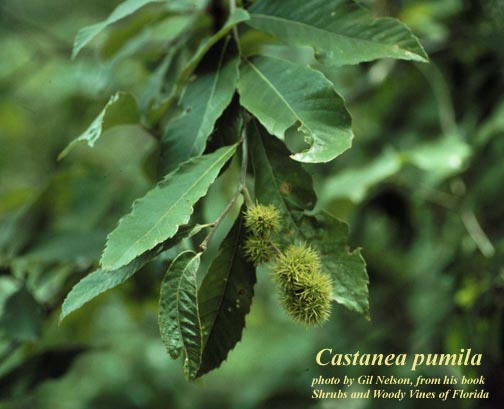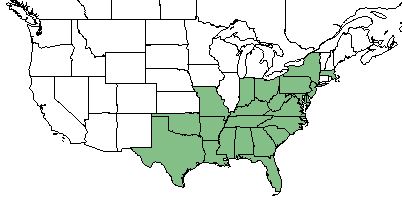Difference between revisions of "Castanea pumila"
(→Description) |
(→Distribution) |
||
| Line 27: | Line 27: | ||
==Distribution== | ==Distribution== | ||
| + | ''C. pumila'' can be found along the southeastern coast of the United States, from Texas to Massachusetts. <ref name= "USDA Plant Database"/> | ||
| + | |||
==Ecology== | ==Ecology== | ||
===Habitat=== <!--Natural communities, human disturbed habitats, topography, hydrology, soils, light, fire regime requirements for removal of competition, etc.--> | ===Habitat=== <!--Natural communities, human disturbed habitats, topography, hydrology, soils, light, fire regime requirements for removal of competition, etc.--> | ||
Revision as of 17:13, 18 May 2018
| Castanea pumila | |
|---|---|

| |
| Photo by the Atlas of Florida Plants Database | |
| Scientific classification | |
| Kingdom: | Plantae |
| Division: | Magnoliophyta - Flowering plants |
| Class: | Magnoliopsida - Dicots |
| Order: | Fagales |
| Family: | Fagaceae |
| Genus: | Castanea |
| Species: | C. pumila |
| Binomial name | |
| Castanea pumila (L) Mill. | |

| |
| Natural range of Castanea pumila from USDA NRCS Plants Database. | |
Contents
Taxonomic Notes
Synonyms: C. pumila var. ashei Sudworth; C. alnifolia Nuttall var. alnifolia; C. alnifolia var. floridana Sargent; C. ashei (Sudworth) Sudworth; C. floridana (Sargent) W.W. Ashe; C. alnifolia
Varieties: Castanea sativa P. Miller
Description
C. pumila is a perennial shrub/tree of the Fagaceae family native to North America. [1]
Distribution
C. pumila can be found along the southeastern coast of the United States, from Texas to Massachusetts. [1]
Ecology
Habitat
Conservation and Management
Cultivation and restoration
Photo Gallery
References and notes
- ↑ 1.0 1.1 USDA Plant Database https://plants.usda.gov/core/profile?symbol=CAPU9